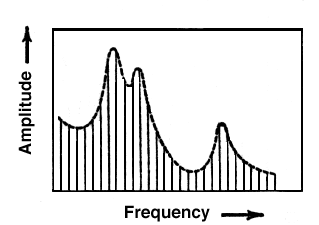A characteristic RESONANCE region. A musical instrument may have several formant regions dictated by the shape and resonance properties of the instrument. The human voice also has formant regions determined by the size and shape of the nasal, oral and pharyngeal cavities (i.e. the vocal tract), which permit the production of different VOWELs and voiced CONSONANTs.
Formant regions are not directly related to the PITCH of the FUNDAMENTAL frequency and may remain more or less constant as the fundamental changes. If the fundamental is well below or low in the formant range, the quality of the sound is rich, but if the fundamental is above the formant regions the sound is thin and in the case of vowels may make them impossible to produce accurately - the reason singers often seem to have poor diction on the high notes.

Spectrum of the vowel "ah" showing three formant regions. The vertical lines represent harmonics produced by vibration of the vocal cords and based on a low fundamental. These harmonics are resonated by the vocal tract to create the vowel's characteristic spectral shape.
Phoneticians usually recognize at least two formant regions as uniquely characterizing the different vowels; however, a larger number are present but have less strength. Three formants are generally required to synthesize a vowel sound. These regions appear as dark horizontal bands on a SPECTROGRAM or amplitude peaks on a line SPECTRUM. The CENTRE FREQUENCY of a formant region is called the formant frequency, as listed in the table below.
Sung vowels are characterized by an additional formant called the singing formant in the range of 2500 to 3000 Hz. It is created by the special resonance of the vocal tract when the larynx is lowered, as practised by trained singers in the Western tradition. The formant not only gives sung vowels a characteristic colour, but also allows the voice to be heard over the accompaniment of instruments or even a full orchestra.
Compare: HARMONIC, INHARMONIC, OVERTONE, PARTIAL, TIMBRE.
Ref.: J. Sundberg, "The Acoustics of the Singing Voice," Scientific American, March 1977, pp. 82-91.
|
|
|
|
|
|
|
|
|
|
|
|
|
|
|
|
|
|
|
|
|
|
|
|
|
|
|
|
|
|
|
|
|
|
|
|
|
|
|
|
|
|
|
|
|
|
|
|
|
|
|
|
|
|
|
|
|
|
|
|
|
|
|
|
|
|
|
|
|
|
|
|
|
|
|
|
|
|
|
|
|
|
|
|
|
|
|
|
|
Average resonance frequencies of the first three formants (F1, F2, F3) of the vowels of men, women and children (from Appleton and Perera, eds., The Development and Practice of Electronic Music, Prentice-Hall, 1975, p.42; after Peterson and Barney, Journal of the Acoustical Society of America, vol. 24, 1952, pp. 175-84; used by permission).
home